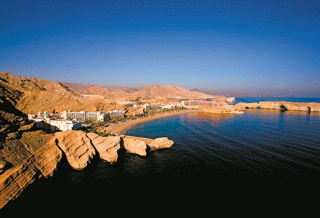
Muscat is the crown jewel of Arabia’s cities. Tied to its shore, both economically and historically, it is more traditional Arabic enclave than fast-paced metropolis, writes Mike MacEacheran
At first there are 60 or so dolphins. Then another 10 appear. Peering over the edge of the boat, a spinner dolphin breeches the glossy surface beside me just to make sure it still has a captive audience. Occasionally, I catch one in the corner of my eye cannon from the water like a submarine torpedo.
“It’s never hard to find the dolphins at this time in the morning,” says the fishing- boat captain. “They are often nearer the shore, hoping to catch tuna that escaped from the fishermen.”
On the horizon, several other clippers bob in the water like wine-bottle corks: it is the tourist high season in Muscat and every skipper tells a story. “I can find them almost every day,” he grins. Our captain could be only 18, but – by nonchalantly steering the boat with his bare left foot – it is clear that he knows exactly where to find today’s most priceless catch. It is around 7am and the air blowing in off Oman’s eastern coast is salty and thick.
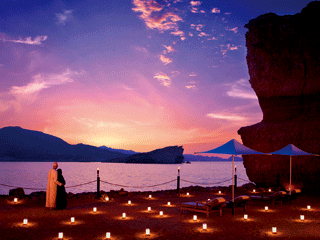
Muscat is perhaps best understood by its relationship with the sea. Imagine putting the Norwegian fjords into a toaster and Oman’s rugged coastline would pop out as their half-baked and hotter younger brother. Sultana-coloured beaches, cliffs and hilltops, which stretch out between the suburbs like greedy fingers, surround the capital and have forced it to look seawards, where it has gladly taken advantage of a bounty of natural resources.
Muscat – which literally translates from Arabic as anchorage – was once home to the great Arabian navigators, yet is still economically dependent on its seas and sailors. Though the pearl harvests and large “Bombay shells” may no longer be sold up the London Thames for silver pennies, Muscat is still home to a strong naval base and is the very essence of the modern day Arabian Gulf lifestyle. In the pre-breakfast morning light, its life aquatic is like a mesmerising sea shanty.
The captain’s mobile phone rings and he reveals a cracked-lip smile. “Aiwa aiwa,” he laments. “My friends come now.” Speaking feverishly, he points to the other boats, which now pirouette on the waves and turn to stake their claim on the shoal of dolphins, which still skim the frothy surface beside us. This morning, I guess we have had all the luck.
Making our way back to Muscat from the periphery of the Strait of Hormuz, we leave the circus to play with its new audience. It is as satisfying as one could ask from such an early rise. Fishermen wave and steer their skeletal boats back into shore. Effortlessly, they drag their patchwork nets onto the sun-dried docks and prepare for market. Apart from the lapping waters breaking against the hardwood teak, jolting like the creaking of a broken pendulum, there isn’t a sound.
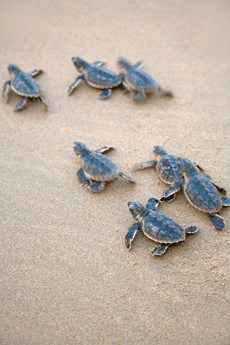 At the harbour pier, Dirk, an amiable German native originally hailing from Mönchengladbach, explains the Omani’s unique philosophy to exploiting the sea. “The locals know these waters so well,” he says. “The only thing that has changed nowadays is we have to make sure every tourist wears a life-vest. If the coast guard spots even one person on our boat without one, then they will send it back to shore.” Other than this simple guideline, Dirk is free to pioneer the nascent scuba-diving industry off Muscat’s coast. It is perhaps this newfound sense of discipline that has started encouraging a greater variety of visitors to Oman’s rugged and starved coastline. At the latest count, Dirk’s Euro Divers outfit has identified nearly 40 scuba sites – boasting sharks, manta rays and the odd lost Caribbean turtle – and Oman is opening up to a new breed of seafarer.
At the harbour pier, Dirk, an amiable German native originally hailing from Mönchengladbach, explains the Omani’s unique philosophy to exploiting the sea. “The locals know these waters so well,” he says. “The only thing that has changed nowadays is we have to make sure every tourist wears a life-vest. If the coast guard spots even one person on our boat without one, then they will send it back to shore.” Other than this simple guideline, Dirk is free to pioneer the nascent scuba-diving industry off Muscat’s coast. It is perhaps this newfound sense of discipline that has started encouraging a greater variety of visitors to Oman’s rugged and starved coastline. At the latest count, Dirk’s Euro Divers outfit has identified nearly 40 scuba sites – boasting sharks, manta rays and the odd lost Caribbean turtle – and Oman is opening up to a new breed of seafarer.Under the leadership of Sultan Qaboos, Oman’s white-bearded patriarchal ruler and very own Captain Haddock, Muscat has become a renaissance city. Even though the capital has been in operation as a port since the early 14th century, seasick-green looks have begun to dart across the border from the diamond polished neighbourhoods of Dubai and Abu Dhabi as the city has grown in stature. It has embraced the introduction of the country’s first six-star business hotel, which boasts decadent suites, butler service, infinity pools and a private beach, and a rise in adventure and eco-tourism – yet it remains overtly retrospective.
The government continually invests in securing its heritage by safeguarding Muscat’s inspiring skyline of ancient olive-lit minarets and hilltop forts. Unlike its Emirati brethren, the Omani administration has also managed this growth despite a turbulent economy, making it sustainable, environmentally sound – and most importantly for the time being – attractive to the tourist dollar.
A short drive north of Muscat and this is in particular evidence. Property developers are in the midst of creating The Wave, a US$800 million luxury hotel and residential project including an 18-hole Greg Norman-designed golf course, and the city’s US$15 billion Blue City marina, near Al Sawadi, is one of the Arabian Gulf’s most ambitious and anticipated fantasies. It confirms Muscat’s status as a classic narrative in the making. If he had ever graced Muscat’s promenade, Ernest Hemingway’s The Old Man and the Sea might have had a definite Arabic flavour.
As the hours roll by like the tick-tock wave motions from the turquoise blue sea, I make my way into the heart of Muscat’s historic quarter, for a typically English stroll along the seafront.
Unlike other Arabian cities, where the majority of the beachfront has become lucrative real estate – accessible only by membership or golden ticket – the best things in Muscat can still very much be free. Flanked by merchants’ houses, marble statue dolphins and Portuguese sandcastle forts, which stand as mighty bastions of times gone by, the Corniche curves playfully into a gentle white-tiled smile and is more than happy to welcome every pedestrian.
Docked harbourside, is Sultan Qaboos’ RY Al Said super-yacht, the third largest in the world, which becomes the Omani leader’s bathtub toy as he tours it along the Gulf coast every summer. Stretching out to 155m and housing its very own helicopter, several tenders and accommodation for any number of visiting dignitaries or Gulf royalty. Similar in size to Moby Dick, it is in stark contrast to the sardine-sized Portuguese dhows and visiting sailboats, loosely tied up to the pier beside it.
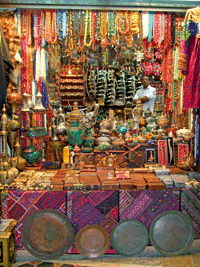 Although the starboard panorama creates an immediate contrast, my waterside stroll showcases the microcosm of Omani life: fragrant sheesha smoke wafts from cafés, white-capped locals saunter in the sunshine and fishermen linger beside their quarry. I pass the nearby Bait al-Baranda, the national museum showcasing the capital’s commercial heritage, cross Al-Mina Street, home to the Samak (fish) roundabout, and stumble upon the Mutrah souq – one of the best in the whole of Arabia – as it begins to light up in the late afternoon. The heart and soul of Muscat, the souq’s labyrinthine maze of pathways resembles a recently caught octopus, which spreads its inky tentacles into a maze of dark corners and torch-lit passageways. Originally founded on sea-borne cargo, it is a 1,001 nights medieval maze of textile vendors, starfish ornaments and Ali Baba baskets, where the locals still come to purchase coffee, perfumes, pomegranates and spices.
Although the starboard panorama creates an immediate contrast, my waterside stroll showcases the microcosm of Omani life: fragrant sheesha smoke wafts from cafés, white-capped locals saunter in the sunshine and fishermen linger beside their quarry. I pass the nearby Bait al-Baranda, the national museum showcasing the capital’s commercial heritage, cross Al-Mina Street, home to the Samak (fish) roundabout, and stumble upon the Mutrah souq – one of the best in the whole of Arabia – as it begins to light up in the late afternoon. The heart and soul of Muscat, the souq’s labyrinthine maze of pathways resembles a recently caught octopus, which spreads its inky tentacles into a maze of dark corners and torch-lit passageways. Originally founded on sea-borne cargo, it is a 1,001 nights medieval maze of textile vendors, starfish ornaments and Ali Baba baskets, where the locals still come to purchase coffee, perfumes, pomegranates and spices. To the left of me is a crooked alleyway, decorated like Neptune’s cave, where coffee pots and bronze lamps outdo each other with reflections and glitter. To the right is a lane like a dusty bookshelf. “Welcome, pleased to meet you,” cries a bearded and twinkle-eyed vendor pouncing on my hesitation. “You buy from me only. I have everything you need.” I am tumbled into his shop and – despite his charming insistence that I buy at least one traditional Omani dagger – I decline. I’m not sure how I would explain that to the customs officials. Curved and sharpened like the world’s most dangerous salmon, it is carried on a hip belt decorated in silver filigree and would instantly turn me into the hardest knife carrier this side of Alcatraz – or nearby Al Ain in any case.
I make to leave the souq’s coral-maze behind for the fresh sea air, and as the sun bleeds behind the Muscat hills, I can’t help but smile. As I continue my way along its dark alleyways, I notice that every second shopkeeper has a collection of similarly polished knives and belts. Historically, they would probably have been used for filleting a recently caught hammour or snapper. Today, I can only assume, as fitting judgement on Muscat’s fledgling tourist status, they will be hung above fireplaces or on bathroom walls around the world. Maybe, I’ll buy one tomorrow.
As I smell fresh fish and chips – or perhaps the traditional delicacy of boiled baby shark and French fries – my mind wanders back to the shoreline, making one thing evidently clear. The Omanis really do like to be beside the seaside.
WHERE TO STAY
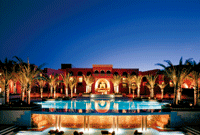 The city’s booming beachside resorts of Bandar Jissah remind visitors why it is so easy to get hooked on Muscat in the first place. Nestled on a hilltop decorated with wonderful contours and ocean archways, the Shangri-La’s Barr Al-Jissah Resort and Spa is Muscat’s most luxurious hotel and getaway. Developed by recognised local artist and patron Mohammad Al Zubair, the resort is split into three distinct oceanfront hotels, each catering to a different type of guest: Al Bandar (the town) is set up for business travellers, Al Waha (the oasis) is more welcoming to families, and Al Husn (the castle) is the resort’s six star opulent gem.
The city’s booming beachside resorts of Bandar Jissah remind visitors why it is so easy to get hooked on Muscat in the first place. Nestled on a hilltop decorated with wonderful contours and ocean archways, the Shangri-La’s Barr Al-Jissah Resort and Spa is Muscat’s most luxurious hotel and getaway. Developed by recognised local artist and patron Mohammad Al Zubair, the resort is split into three distinct oceanfront hotels, each catering to a different type of guest: Al Bandar (the town) is set up for business travellers, Al Waha (the oasis) is more welcoming to families, and Al Husn (the castle) is the resort’s six star opulent gem. “It is a fusion of palatial Moorish architecture in the style of Spain’s Alhambra,” explains a hotel spokesperson. “Al Husn has its own private beachfront, butler service and cigar lounge. It is one of the most romantic destinations in the region.” Looking across to the Gulf of Oman from the hotel’s aquamarine infinity pool – cocktail in hand of course – life really doesn’t get much better.
Next door, Al Waha is furnished with Arabian tents, latticed windows and bespoke pottery, and is created in a traditional Dhofari style, from the southern region of Oman. Home to award-winning restaurant Al Tanoor, which offers the best lobster BBQ in the city, by closing your eyes, it is just a simple step from dramatic deserts to dramatic desserts. Ahem.
Also highly recommended – to avoid the heat of the midday sun – is to venture into the frankincense-infused halls of the resort’s onsite alluring spa retreat. With 12 villas, a vitality hydro pool, herbal steam room, tundra and tropical rain showers and an ice fountain – whatever that’s for – an hour with any of CHI’s massage therapists will leave any visitor feeling like a Sultan. A heady mix of lavender and jasmine oils will result in one’s skin glowing like a well-fed lobster’s without the need for the pain that tomorrow’s sunburn will undoubtedly bring.
Mike MacEacheran








